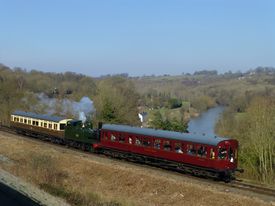| GWR 238 Autotrailer Third | |
|---|---|
 Autocoach 238 leads GWR 1450 away from Highley | |
| Built By | BR(W) Swindon |
| Status | In service |
| Number | 238 |
| Other numbers | W238W |
| History | |
| Built | 1954 |
| Designed By | Hawksworth |
| Diagram | A43 |
| Lot | 1766 |
| 2014 | Arrived on SVR |
The GWR Autocoach, sometimes called an Autotrailer, was used by the Great Western Railway for push-pull trains powered by a steam locomotive. The autocoach has a driving cab at one end, allowing the driver to control the train without needing to be on the footplate of the locomotive. This eliminates the need for the engine to run round to the other end of the coach at the end of each journey. The combination of locomotive and autocoach(es) is known as an auto-train or, historically, a railmotor train, and they were mainly used on small branch lines.
Steam locomotives provided with the equipment to be used as an auto-train are said to be auto-fitted. The driver operates the regulator, brakes and whistle from the autocoach; the fireman remains on the locomotive and in addition to firing, also controls the valve gear settings. The driver, guard and fireman can communicate with each other by an electric bell system.
Many Autocoaches were rebuilt from steam railmotors, although both examples on the SVR were built as autocoaches from new.
Contents
W238W in service
W238W was built at Swindon in 1954, after nationalisation, to a Hawksworth design.
W238W in preservation
It was originally preserved at the Paignton & Dartmouth, before moving to the Dean Forest railway in May 2008. Bewdley Carriage & Wagon Department carried out a full restoration as a contract job, which was completed by June 2011. This included a repaint into early 1960s BR lined maroon livery and application of the name "Chaffinch" (as intended when originally built, but never carried).
W238W moved to the SVR in March 2014 along with Mike Little’s other autocoach 178 and auto-fitted locomotive GWR 1450. It usually sees use on local trains at galas, on footplate experience workings and on charters.
It joined 1450 at the Gloucestershire Warwickshire Railway's 'Cotswold Festival of Steam gala' in May 2017.[1]
See also
References
Railway Heritage Register Carriage Survey
- ↑ Gloucestershire Warwickshire Railway blog 13 March 2017 (Retrieved 13 March 2017)
Links
W238 on vintagecarriagestrust.org
| ||||||||||||||||||||||||||||||